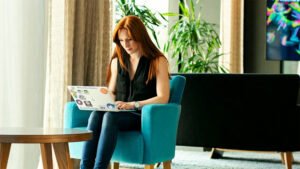In the age of remote work, having a well-organized portfolio is essential for standing out in a competitive job market. Whether you’re a freelancer, job seeker, or remote worker looking to demonstrate your skills, a remote work portfolio is an invaluable tool that showcases your expertise, experience, and ability to work effectively in a remote environment. A portfolio is not just a collection of documents—it’s a powerful visual representation of your skills, accomplishments, and professional journey. This article will guide you through what to include in your remote work portfolio and explain why each component matters in attracting potential employers or clients.
Why a Remote Work Portfolio Matters
Before diving into the specifics of what to include, it’s important to understand why a remote work portfolio is essential. Remote work is fundamentally different from traditional office-based roles, as it requires unique skills such as self-motivation, excellent communication, time management, and technological proficiency. A well-curated portfolio can serve as proof that you possess these skills and are capable of excelling in a remote work environment.
In addition, many remote job listings ask applicants to submit a portfolio or demonstrate relevant work samples. A portfolio provides a structured way to present your qualifications, helping you make a stronger case for why you are the best candidate for the job. It also allows employers to get a clear picture of your work style, creativity, and problem-solving abilities without needing to meet in person.
Key Components of a Remote Work Portfolio
1. Introduction and Personal Statement
The introduction is your chance to make a lasting first impression. This section should succinctly convey who you are, what you do, and your unique qualities as a remote worker. Begin by stating your professional title and the specific area in which you specialize. For example, if you’re a writer, you might say, “I am a freelance content writer specializing in SEO and digital marketing strategies.” This establishes your expertise right from the start.
Beyond just listing your job title, you should also briefly mention your experience with remote work, particularly if you have worked in virtual environments for an extended period. A statement like, “With over five years of experience working remotely across multiple time zones, I have honed my ability to deliver high-quality results while maintaining clear and effective communication,” adds value by demonstrating your ability to work independently and collaborate across different regions.
Lastly, use this space to highlight what sets you apart from other professionals in your field. Whether it’s your strong work ethic, organizational skills, or ability to adapt to new technologies, make sure to showcase your key differentiators. This section is meant to establish your personal brand and make the reader want to learn more about your work.
The introduction serves as an elevator pitch for your portfolio. It provides the reader with an immediate understanding of who you are, what you do, and why you are well-suited for remote work. It should pique the reader’s interest and encourage them to explore the rest of your portfolio.
2. Professional Skills
When it comes to showcasing your abilities, it’s crucial to demonstrate not just the technical skills that make you qualified for the job, but also the soft skills that are essential for remote work. While technical skills are industry-specific, remote work demands certain abilities that go beyond the typical office environment. For example, a software developer would list their proficiency in programming languages like Python or JavaScript. But in a remote context, skills such as time management, communication proficiency, and self-discipline become equally important. You may highlight your ability to manage your own schedule, meet deadlines without direct oversight, and communicate effectively using various digital platforms like Slack, Zoom, or Microsoft Teams.
Remote work also requires a high degree of autonomy and self-motivation. You need to be proactive in tackling challenges and working independently, as there’s often no one physically present to guide you. Being able to efficiently use project management tools like Trello or Asana to track your tasks is a key part of ensuring you stay organized and productive in a virtual environment. This section should therefore detail your expertise not only in the specific tools and technologies required for your role but also in the remote-specific competencies that allow you to work effectively without close supervision.
Demonstrating a comprehensive range of skills that cater both to your specific profession and the nuances of remote work can make you stand out as a well-rounded candidate. Employers are not only looking for technical proficiency, but also for someone who can manage the autonomy and self-discipline required for remote roles.
3. Portfolio of Work Samples
Work samples are one of the most critical aspects of your remote work portfolio. These provide tangible evidence of your expertise and allow potential clients or employers to evaluate your skills in practice. Each work sample should be carefully selected to represent your best work. This could range from articles or reports if you are a writer, to design mockups if you are a graphic designer, or even code snippets for a software developer.
For each sample, you should provide context to help the viewer understand the purpose of the project, the role you played, and the outcome. For example, as a writer, you could share an article you wrote for a prominent blog and explain how it increased web traffic by 20% due to its SEO optimization. In the case of a designer, you might showcase a logo you designed for a startup and highlight how it helped establish the brand’s visual identity, contributing to a 15% increase in customer recognition.
The key here is to show the results of your work, not just the process. It’s important to demonstrate how your contributions led to positive outcomes. Furthermore, a diverse selection of work samples can highlight your versatility and ability to take on a variety of projects. Whether it’s working with different clients, industries, or types of projects, showing a range of experiences can help convey that you are adaptable and capable of handling various challenges in a remote environment.
Work samples are often the deciding factor for remote employers. They serve as concrete proof of your skills and experience, helping potential employers or clients assess the quality of your work. A well-curated collection not only showcases your abilities but also proves that you can deliver results in a remote setting.
4. Client Testimonials or Recommendations
Testimonials and recommendations from previous clients, colleagues, or supervisors provide an additional layer of credibility to your portfolio. Remote work, in particular, relies heavily on trust. Since you’re not physically present in an office, employers need assurance that you can perform effectively in a virtual environment. Testimonials that speak to your reliability, communication skills, and ability to manage remote tasks are incredibly valuable.
Consider reaching out to past clients or coworkers and ask them to provide brief recommendations on your work. These should highlight qualities that are especially important in remote work, such as your responsiveness, your ability to meet deadlines, and your proficiency with remote communication tools. For instance, a testimonial from a client might state, “I worked with [Your Name] on a marketing project for six months. Despite working across different time zones, their communication was clear and timely, and they consistently delivered high-quality results.”
Testimonials help to build trust, especially in a remote work context. They provide social proof that others have had positive experiences working with you, which can be a deciding factor for potential clients or employers. Since remote work requires a higher level of independence and trust, positive feedback from previous clients is essential.
5. Case Studies
A case study goes beyond showcasing individual work samples by providing a detailed look at how you approach solving problems in a remote setting. A case study typically includes the context or challenge you faced, the actions you took, and the results you achieved. This can offer deeper insight into your problem-solving process and work style, which is especially important in remote roles where you might not have direct supervision.
For example, if you worked on a project to redesign a website for a client, you could explain the challenges they were facing, how you collaborated with them remotely to understand their needs, the tools you used to manage the project, and the final results. Including metrics or data points in the case study, such as “increased website traffic by 30%,” can further illustrate the impact of your work.
Case studies not only show your practical skills but also highlight your thought process and approach to problem-solving. In remote roles, employers are often looking for candidates who can independently manage projects, and a case study demonstrates that you have the ability to do so effectively.
6. Work Process and Workflow
In a remote work environment, it’s crucial to have a structured approach to managing tasks, collaborating with teams, and delivering results. The work process section should outline your typical workflow, detailing how you organize your tasks, manage your time, and ensure that deadlines are met. You might also want to share any tools or systems you use to stay organized, such as Trello for task management or Google Calendar for scheduling.
For example, if you work with clients across different time zones, you might describe how you adjust your schedule to accommodate meetings, prioritize tasks to ensure timely delivery, and use collaboration tools to stay in sync with your team. It’s important to convey that you have a clear, effective work process that ensures high productivity even when working remotely.
Employers want to know that you can work independently and manage your tasks without the need for constant oversight. A well-structured work process shows that you can stay organized, prioritize tasks, and maintain productivity while working remotely.
7. Certifications and Education
Certifications and education are an important part of your portfolio as they provide formal recognition of your skills and expertise. If you’ve completed online courses, certifications, or formal education that is relevant to your industry or remote work, make sure to highlight these in your portfolio. For example, certifications in project management methodologies like Agile or Scrum, or technical skills like SEO or data analysis, can demonstrate that you are well-equipped for the job.
Certifications and education show potential employers that you have the knowledge and training required to excel in your role. They also demonstrate a commitment to continuous learning, which is an essential trait in a remote work environment where technologies and tools are constantly evolving.
8. Remote Work Tools Familiarity
One of the primary differences between traditional office work and remote work is the need to use various tools for communication, collaboration, and task management. In your portfolio, make sure to mention the tools you are comfortable using. This could include video conferencing platforms (like Zoom or Skype), project management tools (like Asana or Monday.com), and file-sharing platforms (like Google Drive or Dropbox).
Employers want to know that you can effectively use the tools that are essential for remote work. Demonstrating familiarity with these tools reassures them that you won’t face a steep learning curve when starting the job.
9. Personal Projects and Volunteer Work
Personal projects or volunteer work, especially if done remotely, can be an excellent way to showcase your initiative, creativity, and passion. Personal projects show that you are motivated by more than just paid work, and they give potential employers insight into your interests and values. Volunteer work can highlight your commitment to social causes and your ability to collaborate with diverse teams.
Personal projects and volunteer work can make you stand out by demonstrating that you’re passionate about your field and committed to contributing to something greater than yourself. They also reflect your ability to take initiative and work independently.
How to Organize and Present Your Remote Work Portfolio
Your remote work portfolio should be easily accessible and user-friendly. A well-organized portfolio allows potential employers or clients to quickly find the information they need.
- Use a Personal Website or Online Portfolio Platform: If possible, create a personal website or use an online portfolio platform like Behance, Dribbble, or GitHub to showcase your work. This provides a polished and professional platform to host all your materials in one place.
- Keep It Updated: Regularly update your portfolio to reflect your latest work, skills, and accomplishments. An outdated portfolio can give the impression that you’re not actively improving or staying current in your field.
- Make It Mobile-Friendly: With the increasing use of mobile devices, ensure that your portfolio is responsive and can be easily accessed on smartphones and tablets.
- Keep It Simple and Focused: While it’s tempting to showcase every project and achievement, remember to keep the portfolio focused on the best examples of your work. Quality always trumps quantity.
Conclusion
A remote work portfolio is an essential tool for showcasing your skills and experience in a digital workspace. By including key components such as work samples, client testimonials, case studies, and certifications, you can create a portfolio that effectively demonstrates your remote work capabilities. Remember to keep your portfolio updated, organized, and easy to navigate to make a lasting impression on potential employers. As remote work continues to rise in popularity, investing in a well-constructed portfolio will set you apart and increase your chances of landing your ideal remote job.




